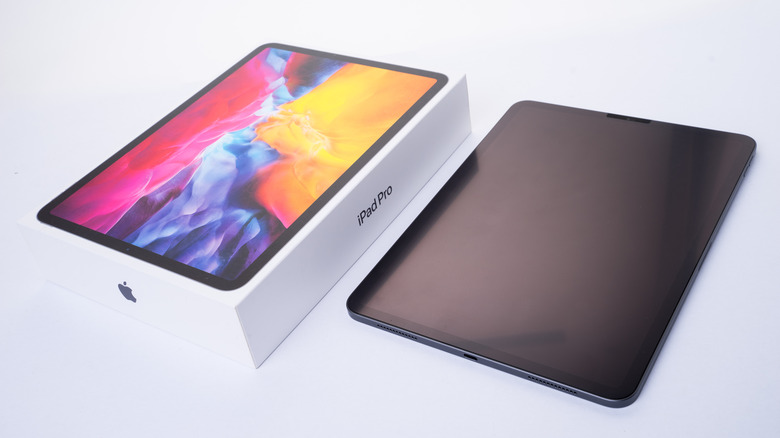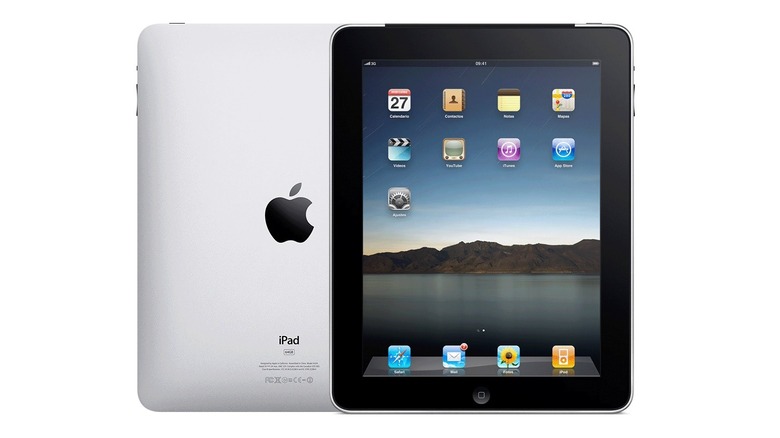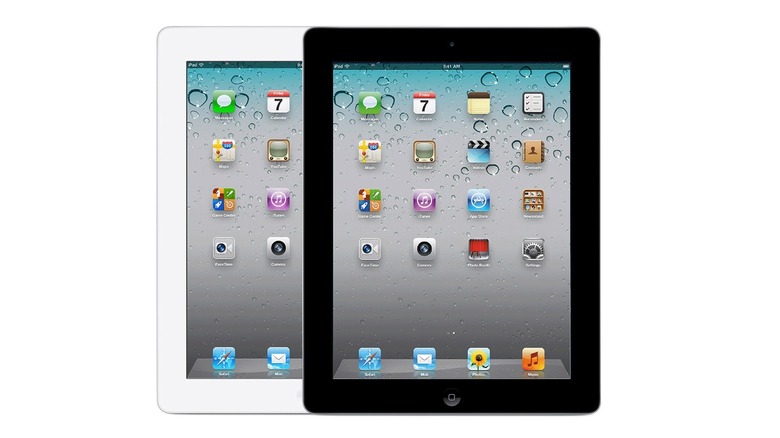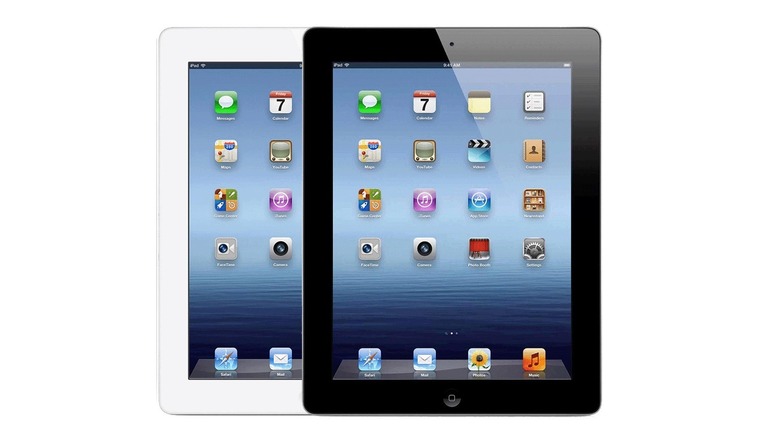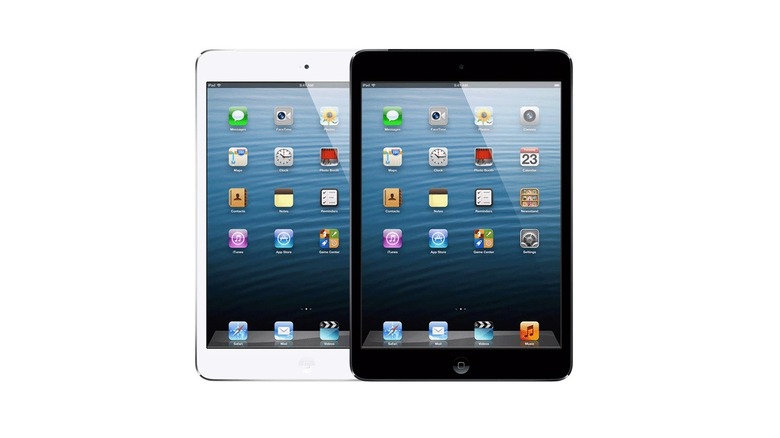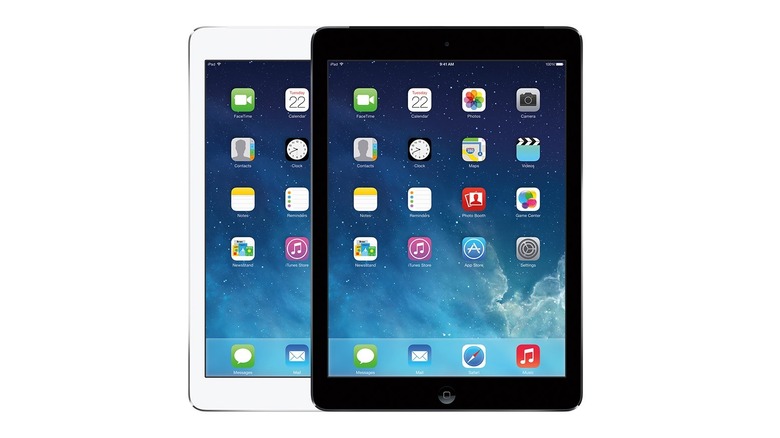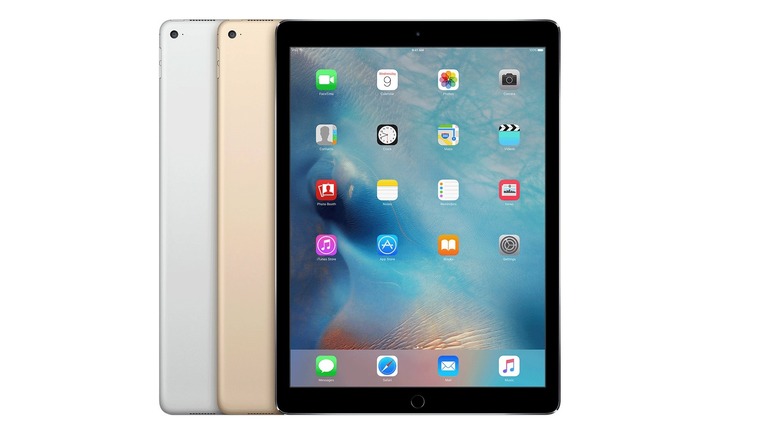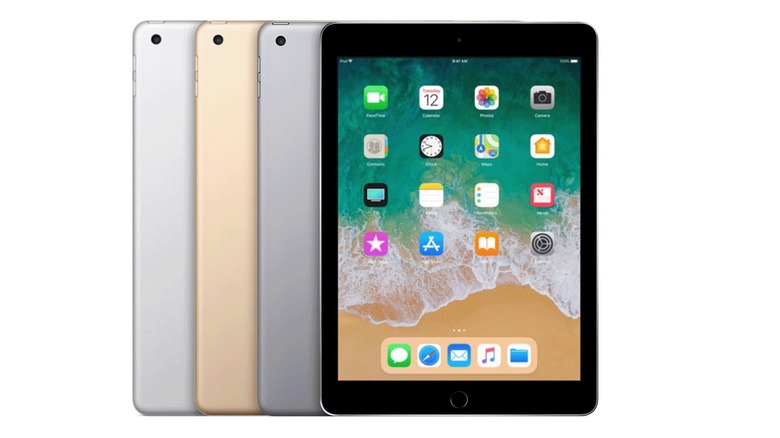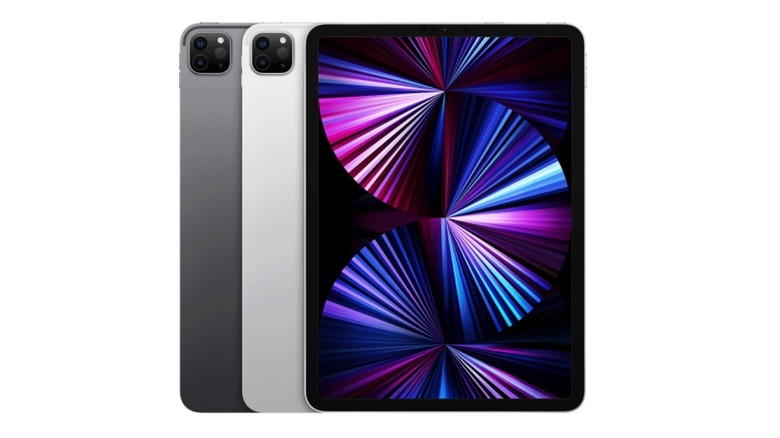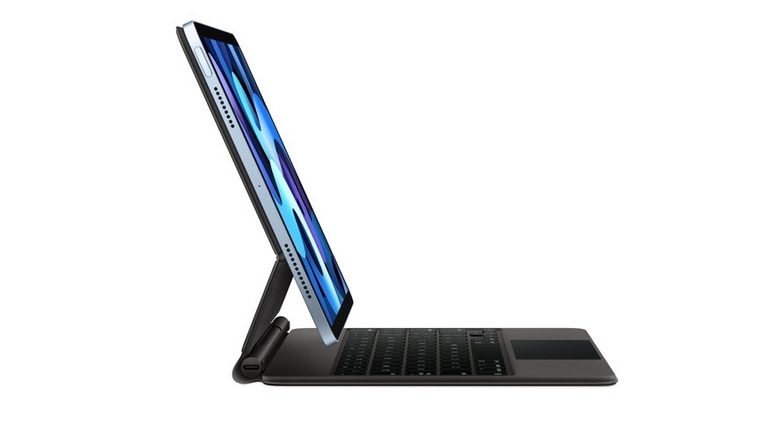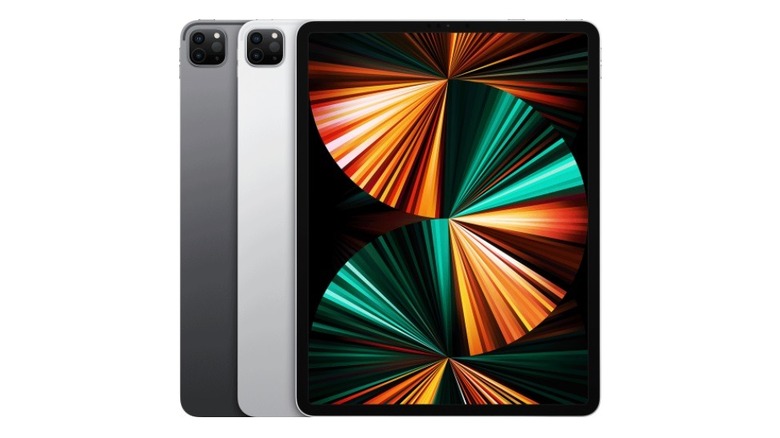The Transformation Of The iPad From 2010 To 2021
One of the ways in which "Star Trek" silently signaled to viewers that the Enterprise was, in fact, traveling through space in the future, was the way in which the crew interfaced with their computers. Gone were physical buttons of any kind. The bridge crew didn't use keyboards or mice, the typical peripheral access points of computers in the modern age. Instead, they spoke to the ship's computer directly or else used a series of flat-panel consoles covered in sleek glass, which responded to their touch.
In some ways, that was achieved — at least on a small scale — with the evolution of smartphones, which ultimately replaced their 9-key user interface with digital touchpoints on a palm-sized touch screen. It was, perhaps, inevitable that those ways of interacting would eventually make their way to more robust computer systems, and if there was any company that was going to pull it off in a big way, it almost had to be Apple.
The emergence of the iPad hit the popular consciousness with no small amount of fanfare and a healthy debate about whether or not it would be a flash in the pan or a lasting addition to the way we connect with our machines. History has, so far, been kind to the iPad because, so far at least, it has continued to evolve.
The first iPad
Like many of Apple's most popular technologies, the brand was not the first to the table but was certainly the most effective. Tablet computers existed prior to the iPad in various forms dating back to the late '60s, (via Techradar). Microsoft beat Apple to the punch by a decade with the tablet PC and even the Kindle, which came out three years before the first iPad, is a tablet computer by some definitions.
In 2010, Apple put its cards on the table by releasing the first iPad. In essence, it was a blown-up iPhone with most of the same functionality. Making it larger did make some activities, like reading and watching video content, easier. The first version offered only Wi-Fi connectivity, making it practical for home use but not much else. A couple months later, beginning in April of 2010, Apple offered a version with integrated 3G capability, allowing you to take your connected iPhone anywhere with a cell connection.
That first model came in at roughly 9.5 by 7.5 inches and half an inch thick and weighed a pound and a half. Ports were pretty spartan, limited to a headphone jack, microphone port, and the 30-pin charging port. While typing was possible, lacking any peripherals made it more cumbersome than using your thumbs on a phone, making the iPad largely a media consumption device.
Second generation iPad
The first-generation iPad made a pretty big splash and helped define the future of tablet computers, but there were a few things missing. Key among them was a camera of any kind. While using the iPad to take photos or video in the outside world isn't the most convenient endeavor, it can be done, and buying any kind of high-end internet-based electronics without a camera feels almost blasphemous at this point.
The iPad 2, released in March 2011, endeavored to fill in some of the gaps in its inaugural product. With competitors hot on their heels, Apple dropped a successor with faster processing, improved graphics, and not one but two cameras, mounted on the front and back, all packaged in a device that was only two-thirds the thickness. That allowed iPad users to make use of Apple's FaceTime capability on a larger screen than is available on a phone. Consumers had the option of two color choices, black or white, with the traditional brushed aluminum backing.
The separately sold Smart Case accessory was a welcome addition as well. The case used magnets embedded in the iPad itself to hold itself closed and could be folded into a workable stand. A separate magnet also communicated with the iPad, signaling that it was closed, and putting the device into sleep mode.
Third generation iPad
A year's worth of innovation meant that the third-generation iPad was familiar while offering improved capabilities. Most obvious among them was Apple's Retina display. Retina debuted on the iPhone 4 but quickly made its way to Apple's other products including iMac computers and the iPad lineup. Retina offers sharper images by quadrupling the number of pixels in a given area, making them small enough that the average human eye can't distinguish them at a reasonable distance (via Macworld).
In the case of the 2012 iPad, that resulted in a screen resolution of 2048 x 1536, as compared to the iPad 2's 1024 x 768. Doubling the number of pixels in both directions has an end result of quadrupling the total. That meant the new iPad was capable of playing video at 1080p, a marked improvement over previous generations.
Keeping the tradition of offering either Wi-Fi-only connectivity or network connectivity via cell towers, the third-generation iPad upped the ante with 4G hardware. In addition, it was capable of generating a hotspot and sharing that connectivity with up to five devices, provided you paid for that connectivity through a participating cellular carrier.
An updated 5-megapixel iSight camera built upon technology from the iPhone 4S, allowing not only for better still photos but impressive video capabilities, at least for the time of its release.
iPad mini
If the evolution of the iPod is any indicator, at some point in every Apple product line they're going to ask themselves what might happen if the thing was smaller. In the case of the iPad, it happened in late 2012 when Apple released the iPad mini.
Apple's first shrunken iPad came in at 7.9 inches as compared to the 9.7 inches of the standard lineup. Additionally, the width was reduced, coming in at just over a quarter of inch, all of which resulted in a tablet weighing only 0.68 pounds.
Internal specs were comparable to the iPad 2, with the same Apple A5 dual-core processor, meaning that consumers who chose the mini over the iPad 3 experienced a slight reduction in functionality over the mini's bigger sibling. The 30-pin charging port that had been the standard to this point was replaced with the lightning connector, which remains a staple of many Apple products even today.
Camera quality was one area that wasn't reduced, using the same tech as the third-generation iPad, with a 5-megapixel camera on the back, and a 1.2-megapixel front-facing camera for use on FaceTime or taking selfies.
Consumers did lose the Retina display which made the previous full-size iPad such a hit, instead opting for 1024 x 768 resolution we'd seen in the iPad 2, in exchange for a smaller profile and a smaller price tag.
iPad Air
While the mini proved that Apple could build an impressive machine in a small package, it did suffer some technological drawbacks in order to get the job done. Something which left consumers with a choice between function and portability.
In 2013, Apple released the iPad Air, in an attempt to meld the best qualities of both the full-size and miniaturized iPad offerings. Coming in at 9.4 x 6.6 inches in height and width, the Air was a closer cousin to the pre-mini devices in terms of display size while nearly matching the mini in thickness. All told, the Air came in at precisely a pound (a little more if you opted for cellular connectivity) giving consumers the option of a higher-powered device with a larger display, while remaining absolutely portable.
The Retina display, which was missed in the mini, made a triumphant return and internal specs enjoyed an upgrade with Apple's A7 chipset first offered in the iPhone 5S. The Air's front-facing and rear cameras remained the same as previous models, at 1.2 and 5 megapixels respectively, with the notable exception of integrated HDR photography support in the rear iSight camera.
While the mini remained a popular choice among iPad adopters, the Air offered a premium experience in a similarly streamlined package.
iPad Pro
If the mini and the Air were exercises in Apple's ability to pack more into a smaller package, the Pro proved that Apple could also go big when they wanted to. Released in 2015, the iPad Pro boasted an impressive 12.9-inch display, considerably larger than their previous offerings.
With Apple's trademark Retina display, the Pro housed roughly 5.6 million pixels, making it the highest resolution of any iOS device, at the time of its release. Beneath its impressive surface lurked the A9X chip, which improved performance and speed, putting the iPad on par with most contemporaneous laptops, (via Apple). That's ultimately what Apple was trying to do with the Pro, build an iPad that could compete with laptops, whether their own or those of their competitors.
The Smart Keyboard, which could be purchased separately, extended the functionality of a tablet to something closer to a laptop while retaining impressive touchscreen capabilities. The Smart Keyboard was a masterclass in convenience, seamlessly integrating with the Pro without the need for Bluetooth syncing or additional batteries. Consequently, the Pro straddled a place somewhere between a laptop and a tablet.
What really set the Pro apart and made it a darling among tech enthusiasts was the introduction of the Apple Pencil. More than just an ordinary stylus, the Pencil could sense both pressure and tilt while capturing finer detail than your everyday stylus, making it a powerful tool for drawing and handwriting.
Fifth generation iPad
When the Pro emerged, it appealed to a particular segment of the consumer base that wanted high-end devices and was willing to pay for them. Its price tag, ranging from $799 for the 32GB model to $1,079 for the 128GB model with cellular connectivity, was a heavy burden for consumers who might want a functional tablet without all the bells and whistles.
Apple's fifth-generation iPad resolved that concern in 2017, offering something reminiscent of their older devices, with updated specs, at a fraction of the cost. The 9.7-inch screen hailed back to the classic size of earlier generations, complete with a Retina display and 3.1 million pixels.
Apple's A9 chip offered performance that was, perhaps, not as good as the Pro while still being perfectly serviceable for the average consumer who was as likely to leave it in the hands of a child to watch YouTube Kids as they were to check socials or answer emails. For those activities, the A9 was enough. It also powered new and recent technologies like Split Screen, which let users run multiple applications on the screen at the same time, and Apple's Touch ID, (via Apple).
There's no doubt that this machine was a shadow of the more impressive iPad Pro, but the $329 price tag was a lot easier to swallow.
Next generation iPad Pro
Apple upped the ante on the iPad Pro in 2018. Two screen sizes were offered, the 12.9-inch as well as a still-large 11-inch option. Onboard storage ranged between 64GB and 1TB but getting that large a hard drive in such a small package was going to cost you.
Buying the new iPad Pro would dent your wallet to the tune of anywhere between $799 and $1,899, depending on the features you chose. Adding the accompanying Smart Keyboard Folio or Apple Pencil—something you really need in order to take full advantage of the Pro's capabilities—would set you back a few hundred dollars more.
By this point, the cameras had improved considerably, which was perhaps not surprising for such a high-end device. The 2018 Pro harbored a 12-megapixel rear camera capable of recording video at 4k. It wasn't all upgrades and extra functions, however. As with many of Apple's products of the time, the headphone jack was dropped, leaving only a USB-C port for both charging and wired headphone connection. Frustratingly, that required an adaptor, of course, it paired seamlessly with Apple's AirPods.
The Pro enjoyed slimmer bezels, offering more screen in the same sized package, in part because Touch ID was ditched in favor of facial recognition. We also saw an updated version of the Apple Pencil to accompany the new Pro, which included a magnetic attachment on the iPad itself to keep the Pencil in place and charge it wirelessly when not in use.
Trackpad and mouse support
With the release of the new iPad Pro in 2020, Apple also announced a Magic Keyboard with trackpad support. While the new iPad Pro was getting some significant upgrades including a built-in LiDAR scanner for mapping the environment and displaying augmented reality elements, studio-quality microphones, and upgraded internal specs by way of the A12Z Bionic chip, the Magic Keyboard announcement had wider ranging implications.
In place of the fabric Smart Keyboard, this Magic Keyboard offered a rigid frame capable of holding the iPad at various adjustable angles, something which is standard in just about every laptop but was previously missing from the iPad lineup.
Importantly, in addition to being available for the new iPad Pro, Apple rolled out the functionality in their iPad OS 13.4 update, making it available for existing owners of previous iPad Pro, iPad Air 2, iPad 5th generation, iPad mini, and later models. Essentially, anyone with a reasonably recent iPad was getting an upgrade in potential functionality without necessarily needing to upgrade. Though, a smaller investment in the needed accessories would be required.
In an industry which typically requires consumers buy a new product every year or so in order to get the latest functionality, this free update was a welcome gesture from Apple.
M1 architecture
Apple's latest addition to the iPad Pro line, released in 2021, represents their most impressive tablet computer to date. The 12.9-inch iPad Pro offers even better display resolution than ever before. Building on Apple's Retina display, the new iPad Pro harbors what Apple calls Liquid Retina XDR display, using 10,000 miniaturized LEDs to backlight the display, (via Apple). That means that picture quality is nearly true to life, capturing an impressive array of colors, highlights, and shadows, even in lowlight conditions.
The Ultra Wide front-facing camera, so often left playing second fiddle in terms of updates, is equipped with Apple's Center Stage, which keeps users framed even as they move around, while on video calls. That's something which has become more important in recent years as so many of us have moved our offices home.
A four-speaker sound system promises impressive sound despite the iPad's small size, not to mention up to 2TB of internal storage, LiDAR scanning, and an option for 5G cellular connectivity. Apple also incorporated support for Thunderbolt, which utilizes the USB-C port to handle peripheral connections to external accessories including ethernet connections and external display at 6K resolution.
In a little over a decade, the iPad has transformed from a coffee table web toy to a formidable device rivaling serious computing solutions. There's little doubt that the iPad has carved a permanent place for itself in the computing landscape.
